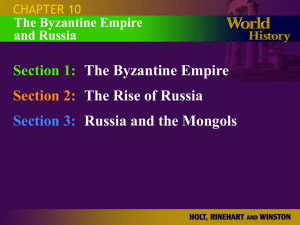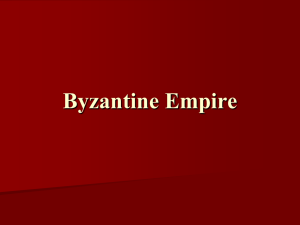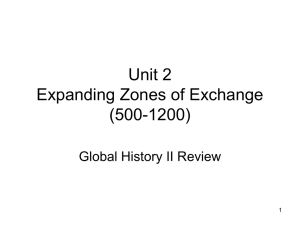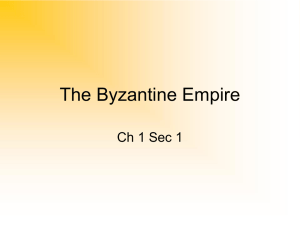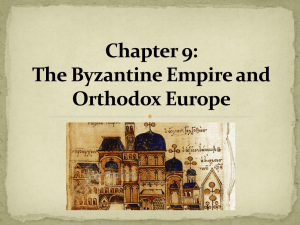The Byzantine Empire and Russia
advertisement
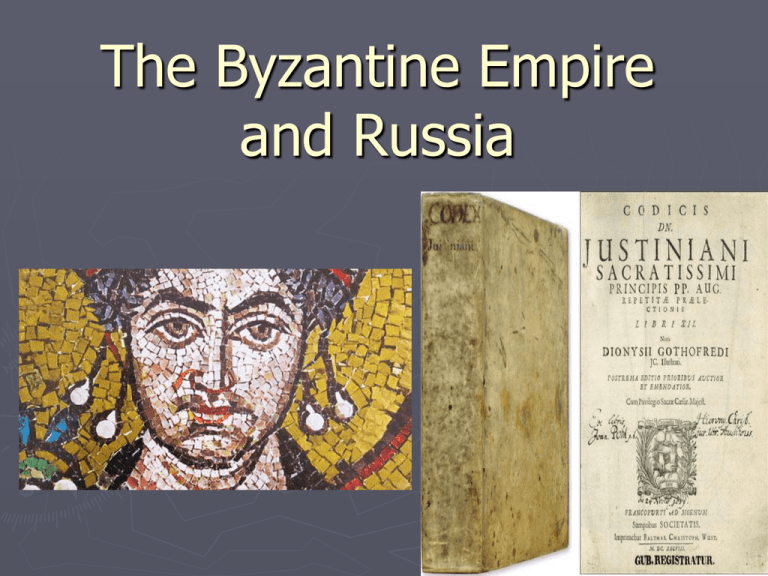
The Byzantine Empire and Russia The Byzantine Empire ► Objectives Identify the factors that contributed to the growth & strength of the Byzantine Empire Explain how the Christian church came to be divided Analyze the cultural contributions made by the Byzantines Explain the factors that contributed to the down fall of the Byzantine Empire The Byzantine Empire The Byzantine Empire ► Justinian Code was a collection of Roman laws Code- contained useful Roman laws Digest- summarized Roman legal opinions Institutes- guide for law students Novellae- laws passed after AD 534 Byzantine Empire ► Justinian Code Formed basis of Byzantine law Provided framework for many European legal systems Preserved Roman idea that people should be ruled by laws, not by leaders whims ► Able Advisors Theodora- encouraged Justinian to increase women's rights ►Altered divorce laws, allowed Christian women to own property equal to a dowry Belisarius- General of the army, ended Nika revolt Strengths of the Empire Strong and Centralized Government ► Officials were skilled, efficient, well paid ► Created alliances through marriages ► Military forces well trained, weapons/armor well designed Greek Fire- chemical weapon of the Navy, liquid that burst into flames ► Eastern Roman Empire Constantinople was source of strength, location allowed control of sea trade routes between Europe and Asia ► The Christian Church ► Icon- holy picture of Jesus, the Virgin Mary, or the Saints ► Iconoclasts- believed having icons was the same as worshipping idols ► Iconoclastic Controversy was a battle about the use of icons in the Christian Church The Christian Church Roman Catholic Eastern Orthodox No Married Priests Married Priest allowed Icons No icons allowed Icons rejected at first then later accepted Leadership Roman Pope was supreme church authority Patriarch of Constantinople Clergy Trinity Believed God the Father Accepted Holy Trinity was more important than the Son or Holy Spirit Byzantine Culture ► ► Cyril and Methodius created the Cyrillic alphabet to teach the Bible to Slavs Art Religion was the main subject Murals, Paintings, icons, and mosaics Location of image important Helped people look toward the afterlife Byzantine Culture ► Architecture Built the Hagia Sophia…a church Byzantines were the 1st to solve the issue of putting a dome over a rectangular building The Decline ► After Justinian died the empire was weakened and taken over by various groups from different locations The Seljuiq Turks capture of Asia Minor affected the empire because it was a source for food and soldiers. Western Roman Empire helped regain Constantinople but later captured the city ► The Byzantine Empire was conquered by the Ottoman Turks The Rise of Russia ► Objectives Explain why different peoples settled in Eastern Europe Describe how Kievan Russia differed from the Byzantine Empire The Setting and People ► ► ► ► ► Ural Mountains serve as a border between Europe and Asia The steppe covers the southern part of the great plains of Russia Rivers crisscross the plain to provide transportation Eastern Europe primarily populated by the Slavs Vikings moved into Eastern Europe to build trade routes Kievan Russia ► ► ► ► Cities of Kiev and Novgorod lie along the Viking trade route Rurik- leader of the Rus people Kiev prospered bc of location as trade route between Constantinople and the Baltic Sea Kiev served as the capital for 300 years Kievan Government ► ► ► ► Governed by princes and a council of nobles called boyars Held town meetings (veche) to and discuss important matters…war and disputes between princes Yaroslav the wise introduced the Pravda Russkia, a code of laws “Russian Justice” was a combination of fines and vengeance Kievan Religion ► ► ► ► ► Traders and Greek missionaries brought Christianity to the area Vladimir I- 1st Russian ruler to convert to Christianity in order to marry Byzantine emperor daughter Ordered Kievan Russia to become Christian Many worshipped the spirits of their ancestors or gods of nature Religious writings, singing, and art dominated the culture Kievan Economy ► ► ► ► 2 agricultural regions, the steppe and taiga Traded agricultural products and provided slaves to the Byzantines Trade helped develop Kievan into a strong, wealthy power Kievan Class Society Local Princes and family Boyars Town Artisans and merchants devoted to trade Peasants, produced all crops that fed Russia Clergy- performed religious ceremonies and ran the hospitals and charities Russia and the Mongols ► Objectives Identify the ways in which Mongol rule affected Kievan Russia. Describe the effects of Moscow’s growing power and independence. Attacks on Kiev ► Reasons for decline Declined due to infighting among Kievan rulers sons Turkish Polovtsy controlled trade south of Kiev Competition with Italian city-states that developed new trade routes The sacking of Kiev Mongol Invasion Kievan under the Mongols ► Ruled from 1240 to about 1500 ► Gained wealth by taxing heavily ► Used peasants for as labor for projects ► Mongol influence Built roads to improve transportation Improved communication Customs, traditions, behavior, and some language entered Russian Society Kievan Russia & its neighbor ► Lithuania and Poland established hostile kingdom to the eastern Slavs ► Poland converted to Catholicism (Western Christianity) ► Other Slavs kept the eastern Orthodox religion ► Slavs become suspicious of Western Europeans Rise of Moscow ► ► ► Prince Ivan I was known as the Great Prince by the Mongols Head of the Orthodox Church moved to Moscow Ivan the Great Took control and power away from the Mongols Established independent state of Russia Began absolute monarchy in Russia Ivan IV…the Terrible ► Became heir to throne at age of 3 ► Took the title of czar ► Developed modern legal system and code ► Renewed trade with Western Europe ► Formed the oprichniki to arrest boyars ► Laid foundation for new Russian state that stretched from Siberia to the Caspian Sea Church Growth ► Grew richly by acquiring land and donations ► Became the center of the Orthodox Church after the fall of Constantinople ► Called Moscow the “Third Rome” ► Elaborate dome churches ► Thought churches would inspire people & make Russia the spiritual light to the whole world.
